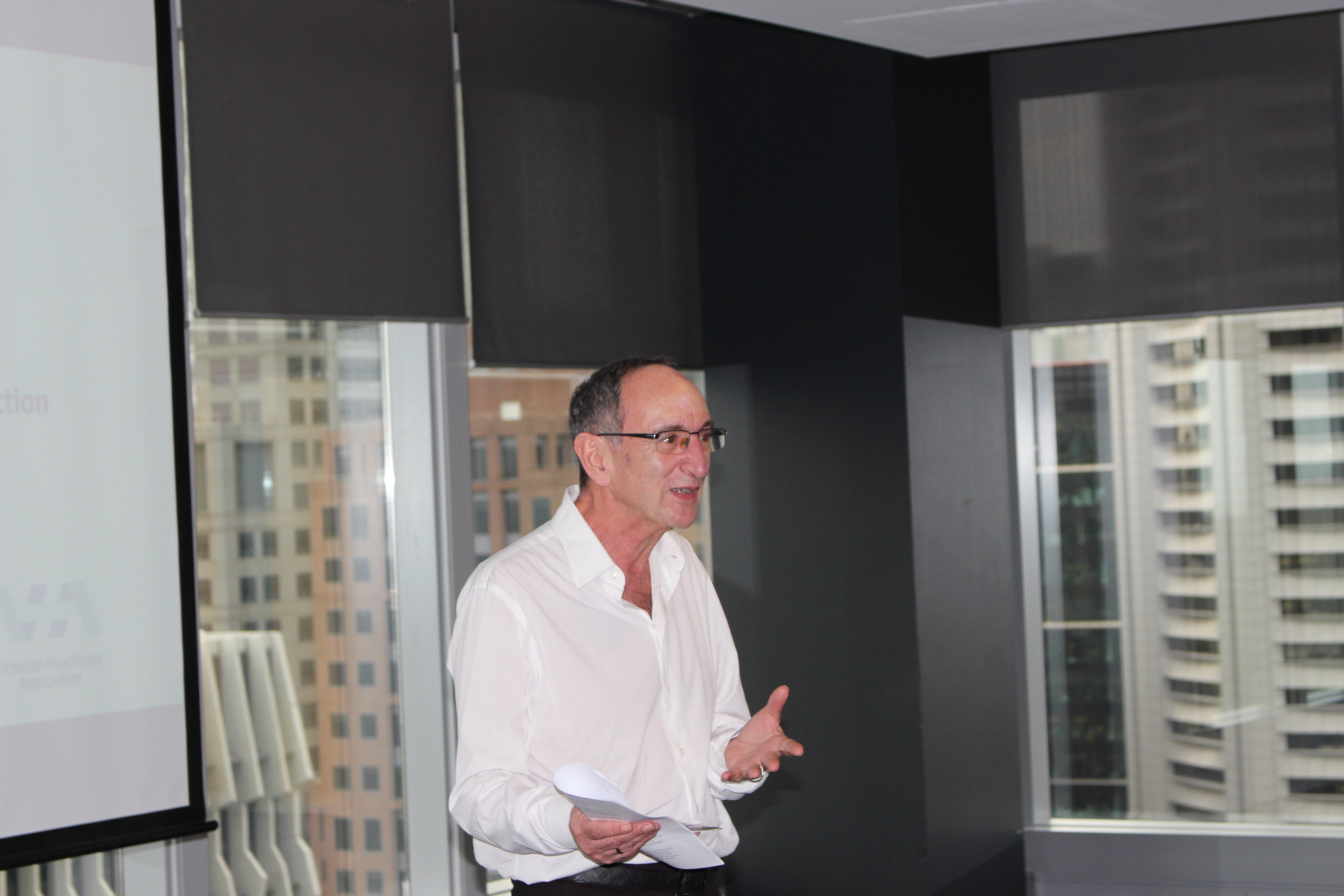23rd October, 2019: 5:45 pm – 8:15 pm
As clinicians and within our health system, we, collectively, are no longer simply dealing with individual ailments. We’re seeing a substantial increase in chronic diseases, multiple co-morbidities on top of increasing aged population. Join Mike Roberts, UCLPartners, and Nick Buckmaster, RACP as they discuss practical changes being made in the various healthcare systems, what they’ve already done to start preparing for the shift and what successes they’ve encountered.
previous event
Successful Community Engagement: Real Experiences on How to Do It Well
14th August, 2019: 5:45 pm – 8:15 pm
With our long-term sponsors, EY, please join us for an exercise on execution and how to achieve real community engagement.
The Politics of Healthcare wrap up
Thank you to our wonderful sponsor KPMG and our excellent panellists John McDonough and Marie Bismark. What an amazing and enlightening discussion, moderated by Euan Wallace, on “The Politics of Healthcare”. Here’s the wrap up: Politics and Healthcare The two are inextricably linked and inseparable. In many countries, universal healthcare coverage is an accepted right; in others, it’s still contested terrain today. It’s a very complex equation. The health care system we have today is influenced by political history: in Australia, this is the funding divide between states / territories and the Federal government; in the USA, “socialist thinking” is not in the psyche of many. The current political turmoil globally reminds us of the fragility of the system and the effect this can have on public sector services such as health and education. Note Who’s Communicating the Message Professional organisations, who are seeking promotion of their specific view, are very wily, well-funded and have enormous depth: they’re good at defending their turf. They are extremely effective in knowing what processes to play and how best to play them. For example, don’t be fooled by opinions / viewpoints / critiques made by “astroturf consumers” who look like grassroots consumers who are actually more professional than you think! So, make sure you look well into the roots and background of the advocates to really understand the essence of the message and underlying motivation. Effecting Change and Influencing Healthcare Provisions and Healthcare Itself The best influence is often from the ground-up. With a focused message, we need the power of not only the patient voice but also the community voice. This was clearly demonstrated by the Obamacare experience when the threat of repeal was on the horizon. Sometimes, even a single piece of research can produce impactful change, especially when the timing is right. For example, the regulation of surgeons at 70 or above was instituted by the Royal College of Surgeons in Australia – this was done prior to the full publication of the underlying research. We are reminded we all have a role to always treat patients with care and compassion. Make the Message Personal Politics is personal; so, with the right content, make the message and interaction compelling and commensurate. Understand your politician’s motivation and, if it aligns, the opportunity to make an impact is there. As an individual, it’s a matter of having your “compass setting right” and seizing the opportunity when it’s available. Don’t Lose Faith The Millennials are big influencers and are being educated, quickly. The results of the recent Federal elections, both here and in the US, were a bit of a surprise. It’s been an awakening. The Millennials are a very compelling consumer segment and can force change by politicising their purchases. The final word from our panellists: Small groups of citizens can make a difference; andBe optimistic that, in the long-term, we will change things. Additional links if you’re seeking a better understanding to what’s happening in the US and an explanation about how the US government is set-up and how it functions (James Madison’s Federalist Papers #10 and #51) plus links to Marie Bismark’s research on “identification of practitioners at high risk of complaints” and the NY Times article on surgeon retirement and mandatory screening: Federalist Paper #10: Paper #51: Bismark’s research: Times article:
A.I.: Digital Demon or Darling wrap up
Those who attended our evening event in March on Artificial Intelligence were subjected to a deeply enlightening and educational discussion from Neville Board, Chief Digital Health Officer, State of Victoria; and Tara Donnelly, Chief Digital Officer, NHS England. Thank you to our fantastic host Jason Micallef and sponsor The University of Melbourne and our moderator John Stanway, CEO, The Royal Children’s Hospital. Here are the top three takeaways from the evening: Artificial Intelligence doesn’t have to work at the bedside or operating table – think of the example of prioritising ambulances through traffic lights; Define the underlying problem you’re trying to solve and then focus on the solution. Take a step back and understand / picture the whole model of care that’s at play; andDon’t build it, create the market for it – others will come, partner and help build the solution! Here’s the wrap up: What is Artificial Intelligence? It means many things to many people. At Van Wynn’s base definition, it’s computers doing the tasks that humans do. Quite often, we think of it as highly complicated business rules with very large data sets. However, the actual application is much broader than that. One example is the City of Liverpool and its use of A.I. to change traffic lights to allow prioritising ambulances or Andiamo in designing custom-made splints for children in days for immediate wearing (as opposed to taking months which, by that time, the child had already outgrown them). Sometimes, it involves simple algorithms that reduce or prevent harm. It’s in areas of diagnoses and identifying patterns where fatigue can play a part in diagnostic errors. It’s proven helpful in allowing remote health experts to “plug in” to give opinions. We can also use it to analyse reactions to certain medicines for people with multiple morbidities. A.I. is often touted for its cost savings which is not very engaging for clinicians. Should we change the core narrative to focus on safety where the patient benefit is so clear? There was also the example of a children’s hospital in Pittsburgh, USA which uses A.I. to flag “red, amber, green’ issues for full visibility for everyone to see: clinicians, nurses and parents. Privacy on the Use of Data and the Issue of Cyber Security The consensus was we haven’t done a great job on this in getting people to agree to use their data and addressing their trust and privacy concerns upfront. We need to be better at gaining the “social licence”, acting responsibly and winning the public’s trust. We need to improve our messaging and ask upfront so people offer their consent to participate. How do we navigate this? NHS UK uses their “app” as the main way to authenticate yourself and then you gain access and can connect to larger groups. It seems the public is on board and their appetite for adoption is way ahead of the government: they are not waiting. In many cases, parents are already granting clinics temporary access to their child’s data. So, is it about better engagement or is it simply because the government is lagging? The discussion then moved into the issues around the electronic medical record and the specific example of My Health Record in Australia and how messaging created a lack of assurance for the public. Electronic Medical Record (EMR) Digital technology can play a key part in connecting and helping patients and doctors but there can be unintended consequences: how much time are we spending on the computer vs. actual patient time? We need more eye contact! Quite often, the issue is a lack of workflow consideration. Eye-tracking analysis on key tasks has shown the discharge department is often more concerned about the time it takes to discharge a patient rather than on the patient being discharged. We need to get to the point where technology is demonstratively helping doctors but it’s sometimes hard to show. “Voice applications” should improve things. The consensus was high volume tasks should be the focus of A.I. and using digital technology to connect. We need to shift “high cost, low access” areas to “low cost, high access”. EMR is not a panacea but it’s one step in the right direction. Today’s Pragmatic Assessment It was noted long-term conditions consume 70% of our hospital resources. Most of the time, we’re looking at the ex-post analysis with the focus on hospital-acquired complications (HAC’s) and their consequences. Perhaps, we should be focusing on actual prevention. NHS UK has flagged an interesting statistic on “digital therapeutics” based on over 350,000 applications: there’s an inverse relationship between good practice and real beneficial impact vs. well-liked and high usage apps. We should be focusing on the mental health space as this would be a game changer in today’s hectic world. NHS provides a digital front-end for everyone which acts as a “front-door”, allowing people to book appointments and delivering substantive factual health information (as opposed to simply well-liked apps). NHS was now looking into digitising other market segments like maternity, child services and the fringe gap (i.e. homeless) to ensure nobody was left behind. The next step is moving into long-term health issues. The Market, its Forces and Digital Adoption Great innovations often start with and are driven by the market. Sometimes it’s better to get excited about the technology and focus there whilst letting the implementation side figure things out. However, we need to ensure the supporting care system is in place. One example given was that it’s great to have people remotely monitoring their own blood pressure but consider the support when there’s an actual event and possible stroke. Can we get better at spending investment dollars? We should conduct assessments whether we could have done things better, ex-post. In some areas, we should change the settings and accessibility for frequent users. However, in other areas, we need to be mindful whether the end segment can use / access the technology. There was a feeling we should be focusing on digital screening tools and practical applications (and keeping things simple – the “KISS” acronym) but with an understanding and appreciation trials were always easier than full market implementation as we need to improve testing at scale. We should examine other impediments to digital adoption including medical paternalism. The reality is digital convergence is happening all around us but the health sector seems to be the last bastion. Next segments on which to focus include mental health, frail /elderly and complex patients. In the end, it’s still all about the “care equation”. Funding Model Within some hospitals, the top 300 complex patients consume 15% of all resources. One key issue is the current funding model doesn’t support the care model needed: we need a different form of funding. One possibility is to consider 3 or 4 different models of care. The challenge though would be the associated workforce required to implement and the amount of work to have the appropriate resources to support it. Another idea is to provide these complex patients with a care co-ordinator and try to reduce their admissions. Departments of Health are also evaluating different funding models including providing financial incentives. In Germany, the government is considering providing a share of the savings for improving health and reducing costs. Other ideas being mooted included models that provide a payment for keeping patients well. Some discussions include offering financial incentives for accelerating digital adoption with even possible disincentives for slow adoption. The bottom line: it’s a very complex equation and we should try to focus on solving one problem at a time. The Role of Government and what NHS England is Accomplishing Digitally The government’s role should be to set out and establish the general Code of Conduct with commensurate rules. From a practical standpoint, we need to show the clear evidence for effectiveness and articulate the associated benefits. Things don’t always require a randomised control trial (“RCT”). However, we need to understand and balance any potential harm vs. unlimited parameters. One example is the “brush DJ” app where it has proven 88% of kids will brush their teeth longer when listening to a song they like. Does the government really need to conduct, and spend all that money on, an RCT for this? NHS England has defined its role and delineated 10 aspects as it rolls out its new digital platform and patient interface to the entire country – its “digital front door”: NHS website provides trusted quality information and comprehensive content / app library to allow people to search medical conditions and perform symptom checks;Used to validate the individual before granting access to other groups and information;“111 online” allows people to get urgent healthcare online through their laptop, smartphone ort other device;You can book doctor appointments and easily change / reschedule them;Access your summary care record;“Digital Maternity” delivers a digital pathway of care from conception to post-natal; (“Digital Child Health”, with a child’s key health information, will be added to allow appropriate sharing with those involved in the care;) Delineate organ donation preferences;Refill / repeat prescriptions;Seek to partner with quality solution providers rather doing it themselves in-house; and Ensure a wide and universal digital participation by helping those who will benefit the most by accessing it – for example, the homeless (giving them actual mobile telephones) and those with dementia. Please take the time to review Tara’s full NHS presentation on “Digital Innovation” on our Events insights page. It’s in three parts: Digital Innovation and How to Make It Work For You At Scale: part 1 Digital Innovation and How to Make It Work For You At Scale: part 2 Digital Innovation and How to Make It Work For You At Scale: part 3
Dying Well: Let’s Talk wrap up
It was a packed house as KPMG hosted our AHN esteemed panel for this amazing evening and discussion. Prof. Mei Krishnasamy encouraged a robust and honest conversation between Prof. Jenny Philip, Dr. Claire Hepper and Prof. Charlie Corke with terrific engagement from the AHN members. As always, the conversation was wide-ranging and it was clear people were passionate about the topic with everyone sharing very thoughtful and personal comments (and, as it was pointed out, we’re all ultimately future consumers). Here’s the wrap up and summary of the salient points from the conversation: We need to start recognising and addressing the inherent dichotomies Culturally, it’s not the “norm” (it’s the so-called “unspeakability of death”) and we’re not prepared to speak about the final stage: we need to get better and more sophisticated at it. We often expect clinicians to have these difficult conversations but we don’t arm them accordingly and then we don’t reward them for making the tough decisions. Very few people want to live as long as possible. Often, people state they don’t wish to “suffer” with pain (and often it’s the physical pain) but this seems to be a very narrow definition of “suffering”. Suffering has a much broader definition and encompasses so much more – it’s about the long journey but not enjoying the road! At the end of all this, it’s really about “care”, not dying, and the general system is already beginning to show cracks. How do we prevent this from happening and the system completely breaking down? Build on what is strong, not what is wrong There is a tendency in medicine to focus on our failures. For many, we understand a “good death” as being what the person desired. However, someone’s death is often judged by the family, friends who were present. Engage and enable the community to lead For some, dying and death is no longer a taboo subject and yet, for others, it’s possible to have an entire conversation about death without talking about the disease process. We need to engage and enable! As health professionals, we like to see an ordered process in the care we deliver. In many instances, dying doesn’t fit this pattern; so, we assume it not happening. We need to encourage these conversations in the community. This needs to be a community initiative. People highlighted their amazement at the capacity from the local community when tragedy occurs: the sheer drive, love and support provided. Importantly, there’s so much that can be done to help and to give the carers a break. It’s the job of the community (loosely defined) to help the carer. Take every opportunity to have a conversation about death Navigation of the end-of-life is important for everyone to have considered. This includes clinicians and health workers in their own personal life. Many people simply assume their family knows what their wishes are. We need to understand this is not always the case. However, sometimes we’re not good at framing the question. One panellist talked about how they initiate the conversation by talking about “living at the end” and that helps people open up and start the discussion about their wishes. The advent of voluntary assisted dying (VAD) legislation in Victoria will act as a stimulus and catalyst for conversations about death. Regardless of the position you hold as a clinician or person in the community, it’s important to understand the system in which VAD exists so we can ensure the family and friends are cared for after a person’s death. Clinician education and training are both crucial If we expect clinicians to have these difficult conversations, we should ensure they have the correct skills and education to do this properly. Clinicians need help to become comfortable with these discussions and they need to be taught how to have the conversations. It’s confronting (and understandably unfair) for the most junior and least experienced clinicians who are often delegated the task. As a clinician, be informed, refer, manage vulnerability (patients often know it’s the end), be open and recognize it’s okay to say “I don’t know) – just don’t be negligent. Additional links: Cassel EJ (1982). The nature of suffering and the goals of medicine. N Engl J Med. Mar 18; 306(11): 639-45 Shannon’s Bridge is a not-for-profit, volunteer organisation that works at connecting patients, families and existing palliative care services for support and help with home-based care at the end of life:
Healthy Professionals, Better Outcomes wrap up
We know one in four people will commit, attempt or contemplate suicide: we also know one in 50 healthcare professionals will actually attempt suicide each year. Our panel explored this somber fact on a remarkable evening sponsored by Slater and Gordon.
Tackling our Thorniest Problems with a Nudge wrap up
A fascinating conversation, courtesy of our wonderful sponsor University of Melbourne, unfolded as we delved into behavioural insights, “nudging” and co-design and their bearing on health’s tricky problems. We considered what can be learnt from substantive campaigns, such as “Dumb Ways to Die” which aimed to alter risk taking behaviour in public transport, to understanding what has happened in the UK (for example the new soft drinks levy being assessed) and even here in Melbourne (for example The Alfred’s cafeteria food selection menus) to nudge public consumers toward “good” or better behaviours. Simon Bell, Professor of Marketing from the University of Melbourne, kept the panel and the audience on the move throughout the discussion. The background of the panel was extremely diverse (private industry, government sector / policy and academia), with each member being very knowledgeable in the space: Adrian Mills, Partner for Creative, Brand and Media, Deloitte Australia; Charles Abraham, Professor of Psychology Applied to Health, University of Exeter / University of Melbourne; and Sam Hannah-Rankin, Director of Public Sector Innovation, Department of Premier and Cabinet Victoria. The panelists returned again and again to four salient points: It is important to understand the behaviour you are trying to change Some health behaviours are more “sticky” than others and, consequently, are considerably harder to change. The panel reflected on the fact humans are essentially cognitive misers: we tend to follow habitual behaviours rather than forging new ways of thinking or being. This is where the small interventions, considered relevant within Nudge Theory, are key. The panel highlighted our brains have two ways or modes of thinking: System 1 Thinking, the fast part of our brain looking for short cuts, patterns and habits; and System 2 Thinking, controlling the more rational, slower part of our brain. To nudge behavior in the direction we want, we need to understand the basic neuropsychology of the behavior and the associated underlying habits so we can then tap into this when structuring the campaign or trying various ways to challenge and change the habit. The key point is that it doesn’t need to be complex. For instance, a simple sentence can deliver a change in behaviour. One such example occurred with fraudulent benefit claims where the inclusion of a sentence, stating “the department will validate each claim payment”, actually reduced fraud by 75%. Talk to the people whom you are trying to change to ensure co-creation The use of persuasion and behavioural insights have been employed by marketing experts for decades. Nudging and co-production merely amplify the advertising knowledge gained from the fifties. When we apply it to health, we are basically using it for public betterment and the good of society. However, we actually know just telling people to their change behavior is simply not working in health. So, to create the change and make an impactful difference, it’s critical to understand the individual motivators within segmented populations. The “Dumbs Ways to Die” campaign was designed to specifically influence 18-24 year olds and their risk-taking behaviours around public transportation. The key elements were: it needed to speak to the target population; it was based on a “social norming” campaign; and it tried to convey the message in a way they wanted to hear it. The general problem is that health often starts with the convenience of the institution rather than the person. This needs to be completely switched around in order to achieve behavioural change in the health industry. Utilise the EAST framework: easy, attractive, simple and timely The EAST framework was published in 2012 by the Behavioural Insights Team in the UK Cabinet Office. The framework provides a quick and easy reference guide for the application of Behavioural Insights to public policies and practices. The basic idea of the framework is to “lead to services that are easier and more pleasant for citizens to use, and more effective and cheaper too”. Government has a role in changing our behaviours Some selective population issues actually lend themselves better to explicit legislation as a way of curbing poor behaviour. For example, the smoking legislation in Australia has been much more effective in changing collective population behaviour than public betterment marketing campaigns trying to address and change individual’s behaviour. Another such example involves the UK government as it considers levying a sugar tax on the sugar content of soft drinks while the industry is already adjusting to the legislation now by reducing the sugar content of their drinks. Our fantastic evening couldn’t have happened with our terrific panellists and our wonderful sponsor University of Melbourne. Please click on the links below for the presentations referred to by the panellists (they’re on the “Event Insights” tab on the AHN website): The soft drinks levy is working before it has even been applied; Putting real people at the centre of Victorian policies and services; EAST – Four simple ways to apply behavioural insights; and Behavioural insights and healthier lives. Here are links to other resources on behavioural insights and “nudging” from the evening’s discussion: Daniel Kahneman (2011) Thinking, Fast and Slow: Ron Borland (2003) Understanding Hard to Maintain Behaviour Change: A Dual Process Approach: Miranda Ward (2015) Has Dumb Ways to Die been effective?:
Data is Everywhere but Nowhere Around Me! wrap up
What another amazing evening with a vibrant discussion on such a key topic. We’d like to thank our new sponsor Nous Group for their support and, of course, our panellists, moderated by Prof. Mei Krishnasamy, University of Melbourne: Prof. Andrew Wilson – Chief Medical Officer for the State of Victoria; Kira Leeb – Executive Director, Health & System Performance Reporting, Victoria Agency for Health Information (VAHI); and Mike Roberts – Clinical Academic Lead for Population Health, UCLPartners, UK and Clinical lead for NHS COPD and Asthma Audit, Royal College of Physicians, UK. Data is always such an all-encompassing topic and the insight provided by the panel was impressive and detailed. Here’s the wrap up: People need data that is relevant and understandable. The key is it needs to be both relevant and understandable for the specific audience, whether clinician, chief executive or consumer. Clinicians need to see the connection between the data they create and the data they receive. Currently, in Australia, this connection seems to be limited. Patient Reported Outcome Measures (PROM’s) tell a story at scale for the system. The UK’s experience with PROM’s is mainly surgically-related with the key issue being it’s a discrete measure (a point in time or before vs. after) but not great at measuring a continuum of care for an individual’s pathway. Ultimately, it’s not a great care metric. However, over a period of time, it can start to inform or make an impact on actual practice as more of people’s metrics are collected and able to be analysed and compared. Patients need to be supported to ask questions. Patients need to be supported to ask questions of the clinicians related to their own situation and expectations. For example, when considering knee surgery, a patient could ask the surgeon if 4 key things will change for them as a result of the operation. If the surgery can’t deliver better kneeling, perhaps the patient should elect not to proceed if that was a key improvement expectation. Clinical Quality Registries (CQR’s) need a strategy in Australia. CQR’s are expensive and difficult to run and, certainly in Australia, there is patchy application. As with all data, the general rule of “rubbish in, rubbish out” applies, even for CQR’s. Regardless of the source, it’s what you do with the data that is really critical. The NHS audits, run for many years, have highlighted data hasn’t really changed treatment patterns but linking the clinical audit to improvement programs has demonstrated real results. UK experience: clinical audits coupled with improvement can drive significant change. Clinical audit linked to improvement is the UK way and it appears to be generating significant success. There are currently 26 national audits around the NHS and here are some key findings: Reduced number of metric collected, tracked and focused on (from 60 to 6) and provided real-time feedback; Added “best practice tariff” that provides standard payout of 85% for general achievement but increases to 100% if the hospital successfully completes the 2 key items shown to be most impactful; Tariff is returned to clinical unit which allows clinicians to negotiate with hospital senior executives for business case support and funding investment. This has shown remarkable results (28% improvement) in changing treatment patterns. However, it’s starting to plateau; so, additional work is needed to modify and tweak the 6 current metrics. The UK is also starting to consider self-sustaining audits which means organisations will need to identify how best to deliver the data going forward. Final thoughts for Australia Clinicians and the government both need to take a proactive role within the system to bring data, from all aspects, to all players in health. Clinicians also need to own their role in the generation of the data and certainly be suspicious of data but not dismissive. The coupling of audit to focus improvement efforts would be a great first step.
Integrated Care – Master Class wrap up
We kicked off our inaugural Master Class series with the very relevant topic “Integrated Care”, featuring our subject expert Mike Roberts from UCLPartners in the UK. From Mike’s many years of experience and “tinkering” with the system and exploring and testing different approaches and ways of doing things, here’s what he’s learnt with resounding results! We need to: Recognise the drive to Integrated Care through structural change has failed; Have real clinical engagement which should include the carers and other peripheral supporters (a key point to note is, in COPD, 90% of care is performed by nurses!); Identify clinical leaders to help drive and adopt new care models; Implement improved IT systems with proper connectivity; Employ better contractual models that reward good / positive behaviour (as the current models don’t and people simply try to “game the system”); Strive towards “value for money”; Provide a more appropriate support model with good governance that brings in the local authority and provides true social care interface; Track and show the data with real-time results; Offer a range of solutions that can work and let the local decision makers decide on the best option for them; Narrow the measurements and number of benchmarks (Mike used the example where they moved from 52 identifiers down to simply 5 key metrics); GIRFT – Get It (i.e. the diagnosis) Right the First Time; Provide tools, templates and checklists (include one for the patient to confirm minimum diagnostics performed with the clinician); and Embed it! We’d like to thank Mike for coming in from overseas and, of course, our terrific new sponsors KPMG. Stay current with the AHN and look for our next Master Class!
Shift from Talking High Performance to Delivering Optimal Outcomes wrap up
Wow! What an evening! First, we have to thank our terrific new sponsor, the University of Melbourne. Next, we must thank Norman Swan, from The Health Report and, then, of course, highlight our immense appreciation to Michael West for his incredible insight. So, from a “wrap up” perspective, better outcomes are derived in organisations that: Have a clear vision (and a vision in which the leader actually pays attention to and “walks-the-walk”); Have clear objectives with only 5-6 priorities that are championed and communicated often; Possess great people management in an environment where there is low stress and high engagement (read: enlightened leadership, high emotional quotient and really practice compassion and compassion-based hiring); Always listen with fascination as a key to compassionate leadership; Are good at innovation as they can identify areas for innovation and are able to resolve problems innovatively; and finally Develop great team and inter-team workings. If you’d like to revisit the exchange between Norman and Michael, please follow this link to their recorded conversation (27 minutes): webcast of Norman Swan and Michael West – Feb 27th 2018. If you think it’s good, please go ahead and share it with others! The conversation was so rich with insights; so, please read on: 1. About Patient Experience; 2. About Teams; and 3. About Compassionate Leadership. Here are links to some of Michael’s most recent publications: Michael West: staff-engagement-comes-first Michael West: employee-engagement-sickness-absence-and-agency-spend-in-nhs 1. About Patient Experience From his extensive research and many years of experience, Michael concludes that, to really focus on optimal patient outcomes, we must incorporate “patient experience” surveys together with actual patient interviews (i.e. the core details). These, together, tell us about the culture of the organisation. Where Michael is seeing, making and experiencing a quantifiable difference (i.e. evidenced-based results) is the more patients’ views are incorporated into the co-design of the services, the more innovative the organisation is: this then creates the difference and lasting impact. 2. About Teams Michael spent a considerable amount of time discussing the concept of teams: what is a team; why we have teams; non-technical team skills (separate to the typical technical skills needed to perform the tasks) – the sense of cohesion, warmth of support, conflict management, and face-to-face time; team-work and collaboration; virtual vs. non-virtual teams; interpersonal conflict vs. robust debate; and the need for a team to take time out to review and reflect upon itself. One of the most critical points Michael emphasised was for a team to assess its own team performance (not the individuals’) and use a metric on improving the team’s effectiveness in working with other teams (“co-operative effectiveness”). Teams are critical to effective execution and ultimately the results achieved. For teams to be able to perform at optimal levels, people must be able to speak freely about the core issues and be able to promote robust debate. Interpersonal conflict is very damaging and we must be intolerant of this type of behaviour. We need to create “psychological safety” so people can be and will be open and honest. Good team work leads to better quality risk taking and taking time out as a team leads to a 25% uplift in performance. By recognising and taking the proper steps to address this, only then, can we tackle those issues proving to be hurdles to achieving greatness. So, that aspect deals with the staff issue but where’s the patient in all of this? The patient must be at the centre of the team! Michael was emphatic we need to create teams around the patient and the pathway of care. We all recognise patients want high quality, compassionate care but how do we create a model for leadership with compassionate care? At a starting point, we should be able to select and train for compassion. 3. About Compassionate Leadership The problem, Michael felt, is that it’s exhausting trying to be compassionate when there’s such a focus on volume and throughput. Pretending to be compassionate is really exhausting: if you actually have compassion, it’s very rewarding! More importantly, Michael stated that we’re damaging the people who are providing the care. We simply cannot keep piling on the workload – it’s damaging on the caregivers’ health and this has a lasting impact. Consequently, taking the temperature of staff is critical. Michael underscored the strong correlation between performance and levels of staff engagement. From his work, he sees a direct correlation between performance and meaningful staff engagement, not excessive stress and workloads and relative autonomy. All this falls under the umbrella of “great leadership” and excellent role models. Quite often, the key issue cited by employees is about the lack of core leadership and “empty leadership”. Michael voiced his concern we are not adequately preparing our leaders for their roles and “leadership in healthcare” in general. Therefore, we need to teach and help train our leaders. We need a pipeline of good leaders (including inter-generational) and then promote to have the right leaders in place. Execution and performance issues are often related to an organisation’s culture and, as such, it’s about leadership as the leaders are responsible accordingly. If it’s then about leadership, it’s related to “collective leadership” as everyone must and should take on a leadership role of sorts at different times. To do this, leaders themselves must be confident or else they typically revert to the “command and control” hierarchy often seen in health organisations. Michael raised the inherent dichotomy that healthcare, as an industry, employs some of the smartest people but, so often, these people aren’t allowed to make use of their intelligence freely in their decisions. Health industry is such a hierarchical industry, it often creates its own hardships. He noted John Lewis, the esteemed UK retailer, only has three (3) levels of hierarchy. We need to create and support autonomy in the front-line roles. To accomplish this, we need to reduce the levels of hierarchy and listen to the people in-the-know (i.e. the front-line staff). There’s a general lack of training, development and support of the people in the health industry. In all this, organisations and the teams need data and empirical feedback with key metrics on how they are actually performing and engaging. We need to “listen with fascination”. Data and the results need to inform staff, not punish or manage staff. We need to focus on values, not just the technical skills. Healthcare organisations need to have values that match those of the staff. We need compassionate leadership. We need to try to reduce / collapse the levels of hierarchy (remember John Lewis’ 3 layers). We need the boards to buy-in at the top and use the evidence to persuade them. Taken together, all of these have a direct impact on the organisation’s overall financial performance. We invite you to comment and share this on Twitter: @healthnetwrk.
Imagine How the Health System Would Look if Consumers Were in Charge wrap up
Moderated by Professor Mei Krishnasamy, Department of Nursing/School of Health Sciences, University of Melbourne, we had a provocative and candid conversation with our panel members: Susan Biggar, National Engagement Advisor at AHPRA; Matiu Bush, Design Integration Lead, Bolton Clarke; and Liat Watson, Consumer Consultant. Our terrific evening was led off with Matiu Bush recounting a telling story about how a veterinarian provided support for and proactively followed-up on the owner of a recently deceased pet. We can learn much if we know where to look and simply ask and observe. There were so many insightful comments made and here are the salient ones: A fundamental structural change needs to happen to the system: let true “empowerment” occur by giving people access to their own information. We need to hear the consumer at every level. Let’s replace the current model with “real-time” consumer voices and feedback so we can realise the incredible impact of the patient experience. People and patients who use the system have years and years of experience with the system. We need to have a way for these “lived experiences” to seep into the system at every level. We heard the “Birkenstock” analogy: shoes designed by people who “get it” and loved by those who use them. How do we get this innovation and this thinking engrained into the system? We need to get comfortable with the duality of people’s perspectives: patient and clinician. The system is too hierarchical and “hospital-centric”. Let’s learn from the hi-tech sector – they’re already doing it. We need to create revolution in small clusters and change the balance of power. Let’s have “geographical centres of marvelousness”. And finally, “quality innovation” is an oxymoron in healthcare. Innovation is dying. Let’s celebrate our failures and delve into why things fail and what we can learn. In response to Mei’s last question of offering one piece of advice with which the audience could leave, Matiu, Liat and Susan provided the following comments: “follow your patient on social media – they will tell you how they really feel”; “the current Millennial and upcoming generations are already there and living their lives on-line. They access and assess information – they provide and expect rapid responses and blur the lines between being just being ‘consumers’ and becoming ‘co-creators’. They now expect the same from healthcare”; and “make it your role to find out what the worst thing your patient thinks you do” and “connect, connect, connect”. As always, we’re extremely grateful to our sponsor support from Slater & Gordon, hosted by Awash Prasad. Thank you to the many people who attended and who posed wonderful questions and kept the discussion going. Stay tuned for our next year’s events!
Clinical Engagement wrap up
Another terrific evening with our provoking event on Clinician Engagement! The consensus was clear: clinically qualified professionals who are well-engaged lead to better outcomes and better performance. Engagement is a journey, not simply a set of completed actions (as it’s often seen). An organisation’s culture is vital to the journey and in creating a supporting atmosphere for real engagement. All too often, engagement becomes a “check in the box” process without having clinicians involved at the outset. Clinicians should be part of the design. Culturally, engagement and relationship management need to be embedded within an organisation and continually reinforced to stop it disappearing into the black hole of failures. Leadership is fundamental to success but it’s a collective responsibility. Importantly, the conversation critically addressed what not to do when an organisation is seeking engagement; Don’t simply get a group of people together and say “we’re now implementing engagement”; Don’t let it become “tokenism” – be committed top-down and bottom-up; Involve those people who will be affected from the start and pay special attention to those who will be less engaged but impacted by your decisions; Involvement does not equal engagement: make it count; and Be respectful of the individuals, listen to them, use their feedback and act – be very careful of losing any goodwill. The main take away though: understand that engagement cannot be ‘project managed’ – it’s a journey that will take a life of its own. Many thanks to our wonderful panel, facilitated by A / Prof. Helen Dickinson: A / Prof. Christine Jorm, University of Sydney Andrew Stripp, CEO Monash Health Jason Micallef, University of Melbourne David Tickell, Clinical Director Specialist Clinics, Women’s & Children’s Health, Ballarat Health Services Of course, our events don’t happen without the support of our sponsors and we‘d like to thank Slater & Gordon for a superb evening!
NDIS wrap up
As one attendee said: “It was a great event. Great topic”. With an expanded expert panel covering NDIS policy, NDIA, health providers and consumer advocates, it was an informative and invigorating conversation. Here are the top reflections from the night: – The reformed NDIS programme is revolutionary, both here in Australia and around the world. It’s truly aspirational and, importantly, has broad bi-partisan support; – For actual consumer participants, it’s already having a big impact: it’s about choice and control; – There’s still some level of anxiety involved, from both consumers and providers, as the programme is rolled out; – It’s a complex environment and the scale is enormous. Everyone needs to recognise it’s a programme in transition and there are still “kinks” to be worked out. The key is to get people into the scheme as a priority and then work towards outcome-based measurements (and holding the providers and the scheme itself to account); – One area that should be more closely examined is the current capped funding model as it may not match the needs of the participants in an environment where nothing stays the same; and – There’s a tremendous need for capacity building and to make it inclusive and part of the social fabric within the local community. We would like to thank our knowledgeable panel, facilitated by Helen Dickinson: Natalie Anderson, Manager, Ambulatory Rehabilitation Barwon Health Kieran Halloran, Mental Health Services Manager, Eastern Melbourne PHN. Shelley Mallet, Brotherhood of St Lawrence Dave Peters, NDIS Consumer researcher Anne Skordis, Expert Advisor NDIA Also, a big thank you, once again, to our terrific sponsors EY for making it all happen!
Big Data wrap up
Well, what a great evening! Tim Kelsey, Kathryn North and Nick Gruen did a stellar job addressing many aspects of Big Data. We covered key points such as: – Data provides both a good and potentially harmful opportunity to improve health and care; – The current business case has failed to convince the wider community so far that big data has benefits; however, collectively, we have an obligation to contribute our own user experiences to push and further support the case, persuading people to appreciate why the provision of data is important; – Access to data will drive innovation, particularly if it involves aggregated data. We should let data be used by innovators and entrepreneurs to develop freeware apps to support health; – The issues of consent, privacy, opt-in and opt-out were discussed including what the role of the government should be; and – There was widespread optimism that Australia is in a great position to overcome the state and commonwealth divide to connect data and deliver great health outcomes. Thank you again to our wonderful friends EY for making it possible.
Disruptive Innovation wrap up
Thank you to everyone who contributed to our most successful AHN event to date. The quality of the conversation and the energy was outstanding. Special thanks must go to our panel and sponsors, Slater and Gordon. So what happened and what did we think about? Top 4 points are below. We need to keep our eye on both the incremental improvement and on the more flashy innovations (the split screen analogy) The people we engage with in our exploration and search for opportunities to innovate our health system are really important. We need to consider the context we are seeking to change, those that are willing to be involved and those who bring fresh eyes to the situation when constructed a team There is no magic bullet to solve the challenges of our health system. We need the full package of ‘C’s; collaboration, curated spaces, change of culture, conceiving of conceptual ideas and in the end we may get change
Digital Transparency wrap up
We had a brilliant conversation at EY on the 18th of August with Tim Kelsey (current CEO Australian Digital Health Agency), Richard Royle (former CEO Australian Digital Health Agency), Kirsty Elderton (Futuregov) and Andrew Way (CEO of Alfred Health) and we are sorry you missed it. The following points are a brief summary of the engaging conversation that transpired: 1. The sole purpose of open data and better transparency in health is to improve the quality and safety of patients; 2. Making data available alone is not sufficient – we must consider how meaningful it is, paying particular attention to the way it is presented for consumption; and 3. There were many powerful anecdotes including an example of low tech transparency in India that has saved substantial amounts through fraud prevention. Should you wish to know more about what Tim Kelsey, CEO of the Australian Digital Health Agency, has to say, please click on this link
Healthcare Innovation wrap up
Our speaker, David Albury, shared his expertise and experience in Innovation across the breadth of the public sector with an avid audience at EY in Melbourne on the 19th November. Many questions came from the floor with varied angles including the influence of markets and a discussion of the role of the population itself has in the deliver of innovation through co-design. A big thank you must go out to our supporters for this event; EY, Australian Healthcare Association and of course the Melbourne School of Government.
Bridging the gap between creation & application of knowledge
The Office of the Chief Scientist recently published a report on knowledge creation and application in the context of entrepreneurship. It argues that knowledge is ‘the foundation of the highgrowth industries of the future’ (pg. iv). Given that Australia is currently going through somewhat of a transition in terms of the structure of its economy then this is an important issue for the country. To some degree Australia is well placed for this future in terms of its share of the world’s top 1 per cent cited research papers in STEM (Science, Technology, Engineering and Maths) areas. But overall the country is far more weak at bridging the gap between the creation of this knowledge and its application. Australia places ninth for the quality of scientific institutions and only 72nd on Innovation Efficiency (output innovation relative to input in terms of the Global Innovation Index. No Australia Universities place in Reuters’ ranking of top 100 innovative universities. Fewer than one in two Australian businesses report innovative activity of any kind. This report is not an anomaly and other studies reveal similar patterns. For example, the OECD ranks Australia last in terms of relationships between universities and businesses. During a debate at the Melbourne Institute conference last week, the Prime Minister Malcolm Turnbull noted that other countries with similar academic cultures are ‘well ahead’ on industry engagement with university research. Such a state of affairs is depressing for those with an interest in innovation and entrepreneurship, but also offers a huge opportunity to advance this agenda. It seems that in driving this agenda there are two things that are agreed upon. The first is that the journey from knowledge creation to its implementation is not straight forward. This process involves navigating a whole series of different organisations, interests and values. The second point that is agreed on is that universities are central to this process. The recent introduction of Advanced Health Research and Translation Centres to Australia may be one way these activities may be improved in the context of health care. Modelled on experiences in the UK, Canada and the US, these centres bring together universities, health organisations and clinical professionals to focus on producing high quality research and mobilising this into practice. At the University of Melbourne we have a project seeking to evaluate these organisational arrangements as they develop and you should see a report from us on this soon. The Victorian Health Network is another innovation that seeks to support the mobilisation of knowledge, particularly in relation to systems improvement. We believe that knowledge is best mobilised where it is socialised between different actors within a system. By bringing together senior individuals from across the health system with an internationally renowned speaker, we believe this affords the system the opportunity to learn from the best and to think about how it mobilises this knowledge into practice. The first VHN event takes place next week and we have just a few places left. We will be hearing from David Albury on the topic of ‘Health Innovation: From buzzword to disciplined action’. If you are interested in attending then drop us a line to find out more.
Health Innovation: from buzzword to disciplined action
19th November 2015 at 5.30-7.30 pm Join the members of the Victorian Health Network in conversation with David Albury. David Albury is Director, Innovation Unit; Consultant (and formerly 2009-14 Design and Development Director) to the Global Education Leaders’ Program (GELP), Associate of the Institute of Government and a Fellow of the Royal Society of Arts. For over two decades, David has consulted and advised on forming and implementing strategies and policies for transformation and innovation in healthcare, education and other public services. He has worked with and coached senior politicians and policy-makers, leading managers and professionals in local, national and international organisations. He works and speaks nationally and internationally, in the UK, Canada, US, Brazil, Australia and New Zealand, on creating the conditions for whole system transformation and radical innovation – especially, in recent years, on effective approaches to scaling and diffusion. He was, from 2002-2005, Principal Adviser in the UK Prime Minister’s Strategy Unit where he co-ordinated advice on health service strategy, led a major review of education policy and co-authored the seminal report on Innovation in the Public Sector. This Victorian Health Network event has been made possible by Melbourne School of Government, Melbourne University, Victorian Healthcare Association and EY.



















